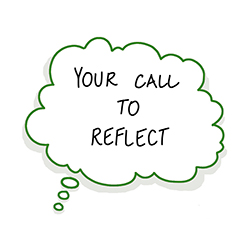3.1 Communication & Conflict Resolution
Learning Objectives
- Recognize how conflict can be viewed from the point of view of individuals, teams, and through the lens of systems of personal and professional values and beliefs.
- Create a conflict resolution plan for a common challenge in Early Care and Education.
- Explain how communication impacts conflict resolution.
Have you ever thought—they just don’t listen to me! Or I have no idea why they would say that! Communication is nuanced, varied, and dependent on context and who we are communicating to. While there are whole courses dedicated to communication, we are going to focus on communication and how it relates to resolving conflict.
 Think about your communication skills. Reflect on your interactions with someone who you thought was a poor communicator. Why did you feel that person was a poor communicator? How was your communication received? What do you think makes you a good communicator?
Think about your communication skills. Reflect on your interactions with someone who you thought was a poor communicator. Why did you feel that person was a poor communicator? How was your communication received? What do you think makes you a good communicator?
Let’s start with some working definitions of communication. Communication includes speaking, listening, non-verbal communication such as tone or volume of your voice, and body language. Communication modes include written, verbal, video, and sky writing (only if you have the budget).
We generally prefer to receive communications in the same way we choose to communicate with others. It is important to remember that everyone prefers different methods of communication. You may want to have a sit down, face-to-face conversation with someone who prefers to speak over the phone or in writing. Culture can also play a role in an individual’s preferred communication style as well as personal experiences, values and belief systems. All of these facets can make communicating during conflict very challenging!
When we enter communications during conflict there are many opportunities for our intended messages to have quite a different impact on the other person. It is important to realize that we cannot control the way our message is received or how someone feels about it, but we can work hard to communicate our message effectively. Tension-reaction behavior can escalate poor communication and make it difficult to navigate conflict.
How can you use communication to resolve conflict? That is a great question! One of the most powerful communication tools you have is asking questions that can help you understand the other person’s perspective as well as what the root cause of the conflict is about (resources, psychological needs, values).
Closed-ended questions…
- Confirm and clarify information—“I just want to confirm, you want me to arrive at 3pm. Correct?”
- Gather specific information— “Which color was the coat? Red or Blue?”
- Focus the conversation—“Can we speak about that tomorrow and focus on parent conferences today?”
- May be perceived as threatening—If your tone and non-verbals convey irritation or anger the questions can be perceived as negative.
Open-ended questions…
- Expand conversation— “That sounds interesting, can you tell me more about your experience?”
- Gather information—“I understand she is not sleeping at nap time. Can you share with me what she is doing instead and what you have done to support her?”
- Involve others in the conversation—“I would love to learn more about your experience with the Smith family. How have your interactions with them been?”
- May not provide specific information—If the question is too open you may get a lot of information but not what you are needing.
- May change focus of conversation—As in the example about the experiences with the Smith family, the other person may start relaying an encounter at the library and not about interactions at the program.
It can be tempting when dealing with conflict to seek advice from others. This is a normal part of being a nurturing and caring individual. Be cautious though and mindful of your ethical responsibility to your co-workers. By speaking directly with the person you have a conflict with you are showing respect and caring which can set the stage for a productive conflict resolution conversation!
Key Takeaway
NAEYC Code of Conduct states: “P-3A.2—When we have concerns about the professional behavior of a co-worker, we shall first let that person know of our concern in a way that shows respect for personal dignity and for the diversity to be found among staff members, and then attempt to resolve the matter collegially and in a confidential manner.”
Three Parts to Communication
Now before you can say it—yes there are actually four parts to communication. As you may know, non-verbal communication is very important. How we say what we want to communicate is especially challenging during a conflict when tensions are high and non-verbals can give away our true emotions. Non-verbal communications (tone of voice, facial expressions, body language) can turn a simple message of “I am fine” into a tense message of “I AM FINE!??!”
The other three parts of communication are thinking, speaking, and listening.
Thinking
Ever wanted to blurt something out and stopped yourself? That is the thinking part of communication.
Stop before you speak and…
- Consider the message. What is it you want them to know? What is the outcome you want from the conversation?
- Consider the person receiving the message. What impact might your communication have? What do you intend to happen? What format is the best for this person? In writing? Face to face?
- Consider the context and timing. You don’t want to have a conversation about conflict during arrival time for children. Where you talk and when you talk are important. Make sure you have a quiet, private space and time to get into the conversation.
Listening
We all think we listen until we find out we were not. Listening is tricky because we typically listen to persuade or share our point of view. As you head into this portion of the communication process remember to…
- Listen more to the other individual’s point of view than share my own.
- Listen to individuals who disagree with me as attentive as I do to those who agree with me.
- Put aside other work and focus on the individual.
- Listen without letting my mind wander.
- Try to put myself in the other shoes and listen for feelings.
- Ask the other what they mean if I don’t fully understand.
- Listen without interrupting, even when I anticipate what the individual is going to say.
Speaking
This part seems pretty easy, right?! You just start talking! Effective speaking requires a few more pieces:
- Adjusting speaking tone and volume to the context and listener.
- Watching for signs the listener is not understanding and pausing or clarifying.
- Engaging the listener through questions or a back and forth exchange.
- Communication, especially during times of conflict, can often have different layers that we may not recognize right away. These layers are hidden dimensions that are present in every communication.
3 dimensions to every communication
Content of Communication. First there is the content of the communication. What exactly do you want to say? More importantly is what is the communication about? During times of conflict and tension-reaction behavior we can struggle to fully articulate what we want the other person to know. Or we bring up information that is not relevant to the current conversation, creating confusion and in some cases hostility.
want to say? More importantly is what is the communication about? During times of conflict and tension-reaction behavior we can struggle to fully articulate what we want the other person to know. Or we bring up information that is not relevant to the current conversation, creating confusion and in some cases hostility.
Emotions. Emotions can make communicating extremely difficult. Even when we think we are concealing our emotions about and during a communication it can still be revealing. During conflict it is usually best to state your feelings, e.g. “I feel frustrated…” etc. This way there is no dissonance between your verbal and non-verbal communications.
Relationship/power. We all speak differently to individuals depending on our relationship with them. Some of us defer to our supervisors, or we may find ourselves speaking tenderly to a small child. This dimension can be tricky when you are navigating conflict with a fellow staff member. Factors such as age, experience, education, or tenure can all influence how we approach our communications. For example, you may have a conversation with someone you consider a friend in one way and a completely different conversation with someone you consider a mentor. These positions of power or importance of relationships can create challenges through assumptions— “my friend will know what I want” to “I don’t think that is how I want to approach it but they are my mentor, so I guess I better.”
 Think back to the beginning of this section where you identified how you are an effective communicator—now that you understand more about the complexity of communication think about recent communication you had. What hidden dimensions were present? How did they or did they not influence your communication and the outcome of the communication?
Think back to the beginning of this section where you identified how you are an effective communicator—now that you understand more about the complexity of communication think about recent communication you had. What hidden dimensions were present? How did they or did they not influence your communication and the outcome of the communication?
Framework for Raising Difficult Issues
- Opener: Agreement with yourself to have the conversation
- I-Feeling Language: Only describe how you feel.
- Practice speaking in positive language that normalizes the conflict and conveys a desire to work through the issue together.
- Pinpoint specific details.
- Acknowledge your part.
- Agree on a solution: Develop a solution that you both create and implement.
Conflict is a natural part of life and working with children, families, and colleagues. As a professional it is our role to collaborate with others to resolve conflict and create opportunities to meet the needs of ourselves and those we work with. When we commit to acknowledging conflict and working through it we show respect and caring for ourselves and our team members. In the end, our nurturing and caring actions can support us in working through some of the tough issues that can come with working with children and families.
Adaptation Credit
Adapted from Chapter 4 in Leadership in Early Care and Education by Dr. Tammy Marino; Dr. Maidie Rosengarden; Dr. Sally Gunyon; and Taya Noland is licensed under a Creative Commons Attribution-NonCommercial-ShareAlike 4.0 International License, except where otherwise noted.

